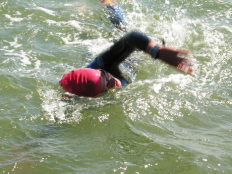Time Terms
- Send-off—the time that a swimmer leaves the wall. Example: 4 x 200 on 3:00;
- Off on:10—When several swimmers are in the same lane, this is a cue to a swimmer to leave 10 seconds off-the-wall behind another swimmer. Example: 4 x 200 on 3:00, "everyone off on :10;"
- "On the top" or "on the 60"—On a traditional pace clock the beginning of a minute is "on the top" and the number is 60. For a digital clock the "top" would be 0;
- "On the bottom" or "on the 30"—On a traditional pace clock the middle of the minute is "on the bottom" with the number 30, with the same number 30 for a digital clock;
- Repetition or Repeat—the number of swims within a set. Example: 3 x 500—you complete three cycles of 500;
- Interval—The amount of time that you have to complete the swim segment and to rest before you send-off for the next interval. Example: 4 x 50 on :60--you are always leaving "on the top" no matter what your swim time is;
- Set—a grouping of certain swims. Example: 4 x 100 free, 5 x 50 free kick;
- Rest Interval—set time for the rest between intervals or sets. Example: 10 x 100 on :30. No matter what time you do the 100 in, you will always have :30 rest.
- Rounds—A certain number of repetitions in an entire set. Example: Three repeats of: (1 x 100, 2 x 50, 4 x 25) with a send-off base of :30 per 25 and :60 between each round. The intervals would look like: 100 on 2:00, 50 on :60 and 25 on :30.
- Straight set—The distance per repetition and interval per repetition remain constant throughout the set. The rest interval becomes dependent upon how fast or slow you swim the interval. Example: 10 x 50 on :60.
More: Body Position Basics
More Time Terms
- Fixed rest set—the rest interval is always the same length of time. Example: 5 x 100 w/ :30 RI;
- Pace—your swimming speed based on your time for a certain distance, usually 100 yards or meters. Example: You swim a 1,000 meter time trial in 21:20; and your 100 meter pace is 1:25;
- Time—how long it took you to swim the distance;
- Build—getting faster within a certain repetition or repeat. Example: 4 x 75 build by 25s, each length gets progressively faster within each 75 rep;
- Descend—getting faster with each subsequent repetition or rep. Example: 4 x 200 descend each 200 by :05--start out slow so that you get :05 faster with each 200.
- Ascend—opposite of descend—you're adding time to the interval. Example: 4 x 25 fast on :30 ascend :05, so #1 is on :30, #2 is on :35, #3 is on :40 and #4 is on :45--you will ideally have more rest with each rep.
- Negative split—the second half of the repetition is swum faster than the first half. Example: You swim a 100 on 1:15 and the first 50 is :39 and the second 50 is :36;
- Broken swim—a larger distance swim is broken into smaller segments with rest intervals after each segment. Example: Broken 200 swim done as 50-25-50-25-50 w/ :15 RI
- Pyramid—Sets that include ascending and descending intervals. Example: 7 x 50 on :50, :45, :40, :35, :40, :45, :50--here you get less rest on the way up and more on the way down the pyramid.
- Ladder—sets that have times for specific repetitions (steps). Example: 400 on 8:00, 300 on 6:00, 200 on 4:00, 100 on 2:00.
More: Decoding a Swim Practice
 Search for your next triathlon.
Search for your next triathlon.
- 3
- of
- 3
About the Author

Karen Buxton is Level-III USA Triathlon certified coach with over 25 years of coaching experience and author of The Triathlete's Guide to Off-Season Training. Coach Buxton works and trains in Greensboro, North Carolina and can be reached at Karen@coachbuxton.com. Find out more about Coach Buxton at www.coachbuxton.com
Get ACTIVE on the Go


Meet Mobile
Swim smarter: heats, lane assignments and real-time results in the palm of your hand.
Available for iOS | Android







Discuss This Article